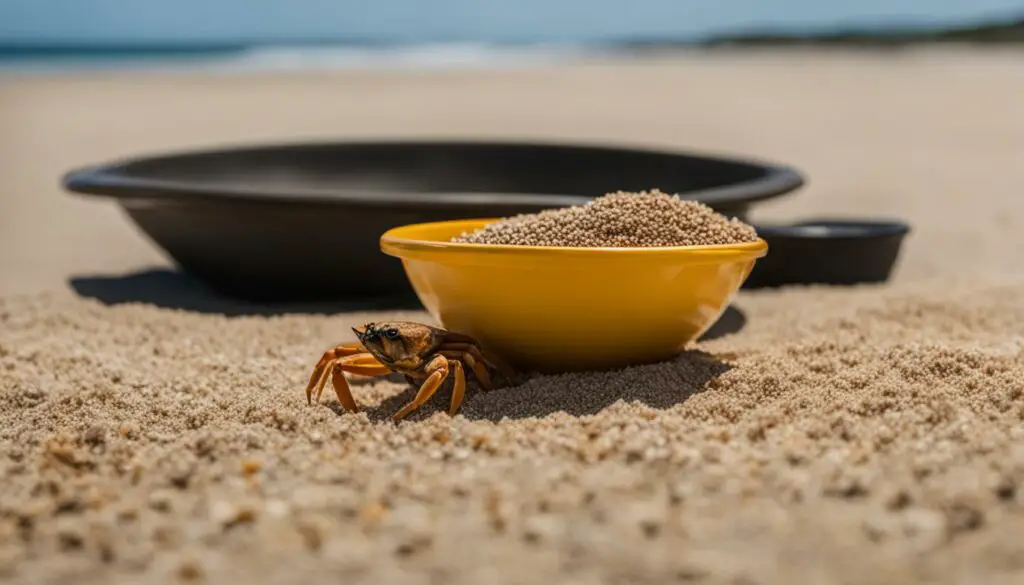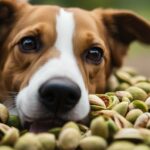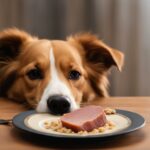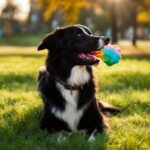As a responsible dog owner, it’s essential to be mindful of what you feed your furry friend. One common question that arises is whether dogs can safely eat crab shells. Understanding the impact of crab shells on your pet’s diet is crucial to ensure their well-being.
Key Takeaways:
- Feeding dogs crab shells can be dangerous due to the risks of choking, puncturing the digestive tract, and intestinal obstruction.
- If your dog ingests crab shells, seek immediate veterinary attention and prevent future incidents by keeping crab shells out of their reach.
- Cooked crab meat, without the shells, can be a healthy addition to your dog’s diet in moderation.
- Proper preparation of crab for dogs involves removing the shells, cooking the meat thoroughly, and avoiding seasonings.
- Remember to introduce new foods gradually and monitor for any adverse reactions or allergies your dog may have.
What are Crab Shells?
Crab shells are the protective outer covering of crustaceans like crabs. They serve as a hard exoskeleton that provides support and protection for the delicate anatomy of these sea creatures. The composition of crab shells primarily consists of chitin, a tough and fibrous substance that gives the shells their strength. These shells are discarded by crabs as they grow, making them readily available in seafood markets and beaches.
While crab meat itself is safe for dogs to consume in moderation due to its high protein content and nutritional value, the shells pose potential dangers. The sharp and brittle nature of crab shells can cause harm to dogs if chewed or ingested. The broken shells can have sharp edges that may lead to choking, puncture or tear the dog’s digestive tract, and even result in intestinal obstruction. It is crucial for pet owners to understand these risks and take necessary precautions to prevent any harm to their furry friends.

The Dangers of Crab Shells for Dogs
Dogs may find crab shells enticing due to their strong smell and texture. However, it is important for pet owners to understand the potential dangers that crab shells pose to their furry friends. While the material of crab shells is not toxic, they can be harmful if chewed by dogs. The sharp edges of broken shells can cause various issues, including choking, puncturing or tearing the dog’s digestive tract, and even leading to intestinal obstruction. It is crucial for dog owners to be aware of these risks to prevent any harm to their pets.
Choking Hazard
One of the main concerns with crab shells is the risk of choking. Dogs that attempt to chew or swallow large pieces of shells can end up with fragments lodged in their throat, leading to difficulty in breathing and potentially causing a life-threatening situation. It is essential to ensure that dogs do not have access to crab shells or any other small objects that they can swallow.
Gastrointestinal Issues
The sharp edges of crab shells can cause serious injuries to the dog’s gastrointestinal tract. When swallowed, these sharp fragments can puncture the esophagus, stomach, or intestines, resulting in internal bleeding, infection, and severe pain. Ingesting crab shells can also lead to intestinal obstruction, causing symptoms such as vomiting, abdominal pain, constipation, and a loss of appetite. These conditions require immediate veterinary attention to prevent further complications.
| Dangers of Crab Shells for Dogs | Safety Tips for Dog Owners |
|---|---|
| – Choking hazard if the shells are swallowed in large pieces | – Keep crab shells out of reach from dogs |
| – Sharp edges can puncture or tear the dog’s digestive tract | – Avoid feeding dogs crab shells |
| – Potential for intestinal obstruction | – Monitor dogs closely during beach trips or outdoor activities |
It is crucial for dog owners to understand the dangers associated with crab shell consumption to ensure the safety and well-being of their pets. Avoiding the feeding of crab shells to dogs and taking preventative measures are essential steps in preventing any potential harm. If a dog accidentally consumes crab shells or exhibits any symptoms of distress, immediate veterinary attention should be sought to provide the best chance for a positive outcome.
Signs of Crab Shell Ingestion in Dogs
When dogs ingest crab shells, they may exhibit various symptoms that indicate potential health issues. It’s crucial for pet owners to be aware of these signs to ensure prompt medical attention and appropriate care for their furry friends. Here are some common symptoms of crab shell ingestion in dogs:
- Vomiting: Dogs may vomit as their body tries to expel the foreign object.
- Diarrhea: Digestive disturbances may result in loose stools or diarrhea.
- Abdominal pain and swelling: Dogs experiencing discomfort in the abdomen may show signs of pain and distention, which can be evident through their behavior or appearance.
- Constipation: In some cases, crab shell ingestion can lead to constipation due to blockage in the digestive tract.
- Weakness and lethargy: Dogs may seem fatigued or lacking energy, which can be a result of underlying discomfort or illness.
- Loss of appetite: The presence of crab shells in the digestive system can cause dogs to lose their appetite or have a decreased interest in food.
If your dog displays any of these symptoms after consuming crab shells, it’s important to seek veterinary attention immediately. Professional guidance and appropriate treatment can help address any potential complications and promote a speedy recovery for your beloved pet.
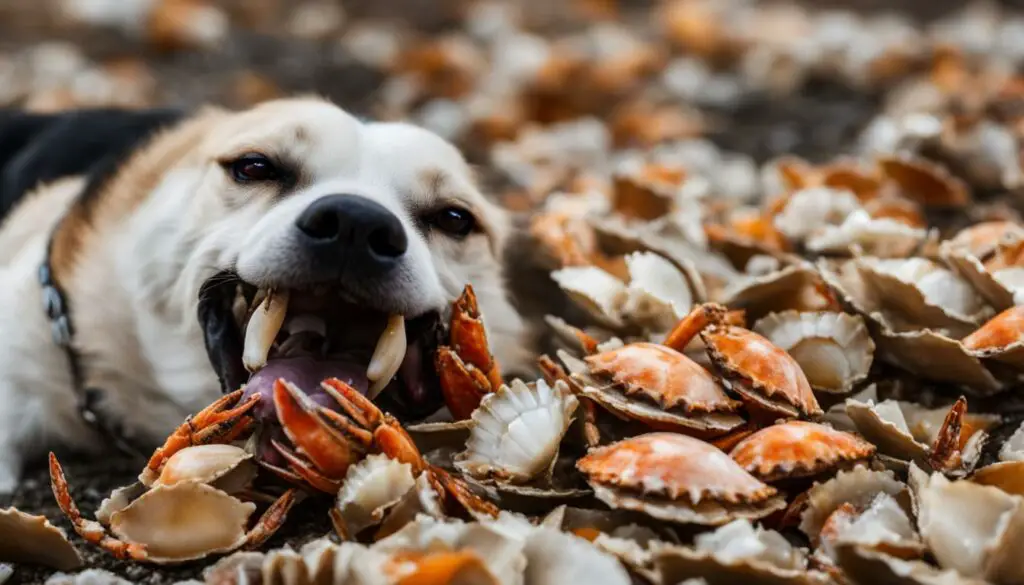
| Signs of Crab Shell Ingestion in Dogs | Actions |
|---|---|
| Vomiting | Contact a veterinarian or Pet Poison Helpline for guidance. |
| Diarrhea | Monitor for dehydration and consult a veterinarian for further advice. |
| Abdominal pain and swelling | Seek veterinary attention to evaluate and address the underlying cause. |
| Constipation | Contact a veterinarian to determine the appropriate course of action. |
| Weakness and lethargy | Seek immediate veterinary care to identify any underlying issues and provide necessary treatment. |
| Loss of appetite | Contact a veterinarian to assess the situation and ensure adequate nutrition for your dog. |
Immediate Actions for Dogs Who Ate Crab Shells
If your dog has consumed crab shells, it is important to take immediate action to ensure their safety and well-being. Here are some steps you can take:
1. Contact a veterinarian or Pet Poison Helpline:
Reach out to a veterinary professional or contact a Pet Poison Helpline for guidance. They will provide you with expert advice on how to proceed and may recommend specific actions based on your dog’s size, breed, and overall health.
2. Observe your dog’s behavior:
Keep a close eye on your dog for any signs of distress or discomfort. Look out for symptoms such as vomiting, diarrhea, abdominal pain, or changes in appetite. If your dog exhibits any concerning symptoms, it is important to seek veterinary care immediately.
3. Prevent future incidents:
To prevent your dog from eating crab shells again, ensure that they do not have access to them. Keep crab shells in secure trash bins or dispose of them properly. It is also crucial to avoid feeding your dog any crab shells as a treat or part of their meal.
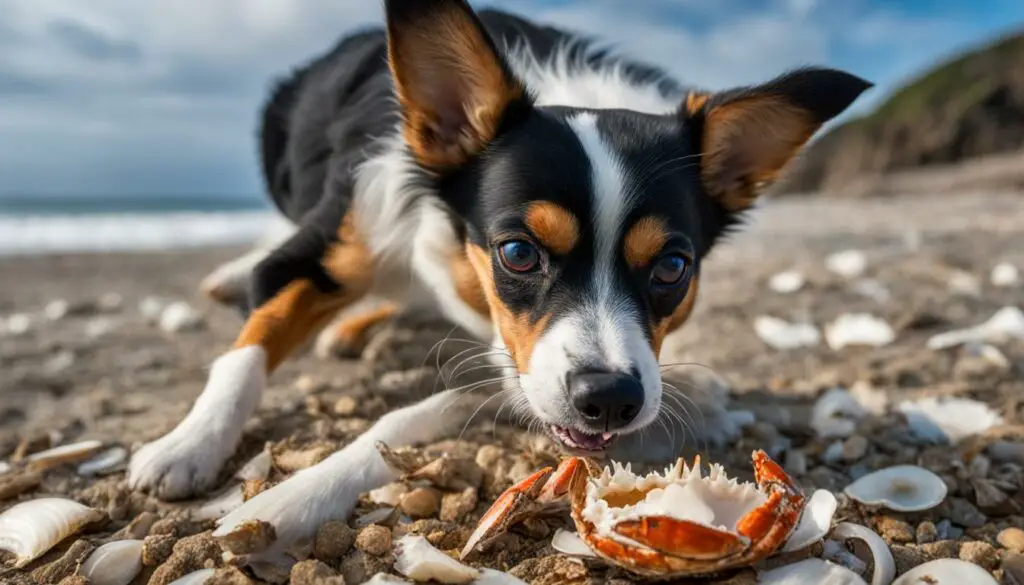
Remember, the safety of your dog should always be your top priority. By taking immediate action and being proactive in preventing future incidents, you can help keep your furry friend safe and healthy.
Understanding the Risks of Crab Shell Consumption
When it comes to dogs eating crab shells, there are several risks that pet owners need to be aware of. The sharp edges of broken shells can pose a choking hazard and potentially cause internal injuries. Additionally, if a dog ingests a large piece of shell, it can lead to intestinal blockage, which is a serious medical emergency.
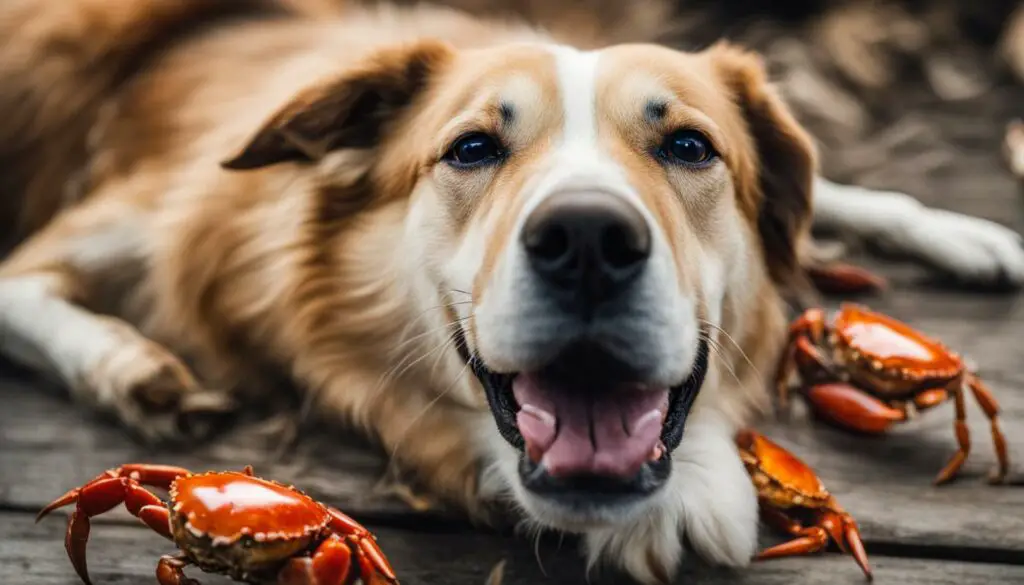
To further understand the risks, it is important to know the potential consequences of dogs consuming crab shells. Choking can prevent the dog from breathing properly, causing distress and potentially leading to suffocation. Internal injuries can range from minor cuts and bruises to more severe damage to the digestive tract, which may require surgical intervention. Intestinal blockage can lead to severe pain, vomiting, and a compromised blood supply to the intestines, necessitating immediate medical attention.
Table: Risks of Crab Shell Consumption in Dogs
| Risk | Description |
|---|---|
| Choking | Sharp edges of broken shells can cause choking, leading to breathing difficulties. |
| Internal Injuries | Broken shells can puncture or tear the dog’s digestive tract, potentially causing severe damage. |
| Intestinal Blockage | Ingesting large pieces of shell can result in a blockage, obstructing the dog’s intestines and requiring immediate medical attention. |
Prevention is key when it comes to protecting dogs from the risks associated with crab shell consumption. Ensuring that crab shells are not accessible to dogs and avoiding feeding them any crab shells can greatly reduce the chances of these dangers occurring. If you suspect your dog has ingested crab shells or is experiencing any symptoms such as vomiting, abdominal pain, or signs of distress, it is crucial to seek veterinary care immediately.
Can Dogs Eat Cooked Crab Meat?
While crab shells are not safe for dogs, cooked crab meat can be a healthy addition to their diet in moderation. Crab meat provides important nutrients such as lean protein, vitamins, minerals, and omega-3 fatty acids. It is important to remove shells and avoid seasoning the crab meat when feeding it to dogs.
Crab meat can be a tasty and nutritious treat for dogs, but it should be given in limited quantities and prepared properly. Dogs can benefit from the protein content in crab meat, which helps support muscle development and repair. It also contains essential vitamins such as vitamin B12 and minerals like zinc, which contribute to overall health.
It is worth noting that some dogs may be allergic to crab or other shellfish. If you suspect that your dog may have an allergy, it is recommended to consult with a veterinarian before introducing any new food into their diet.
When feeding dogs crab meat, it is important to prepare it correctly. Remove the shells completely, as they can pose a choking hazard and cause damage to the dog’s digestive tract. Additionally, avoid seasoning the crab meat with salt, spices, or other additives that may be harmful to dogs.
| Benefits of Feeding Dogs Cooked Crab Meat | Risks of Feeding Dogs Crab Shells |
|---|---|
|
|
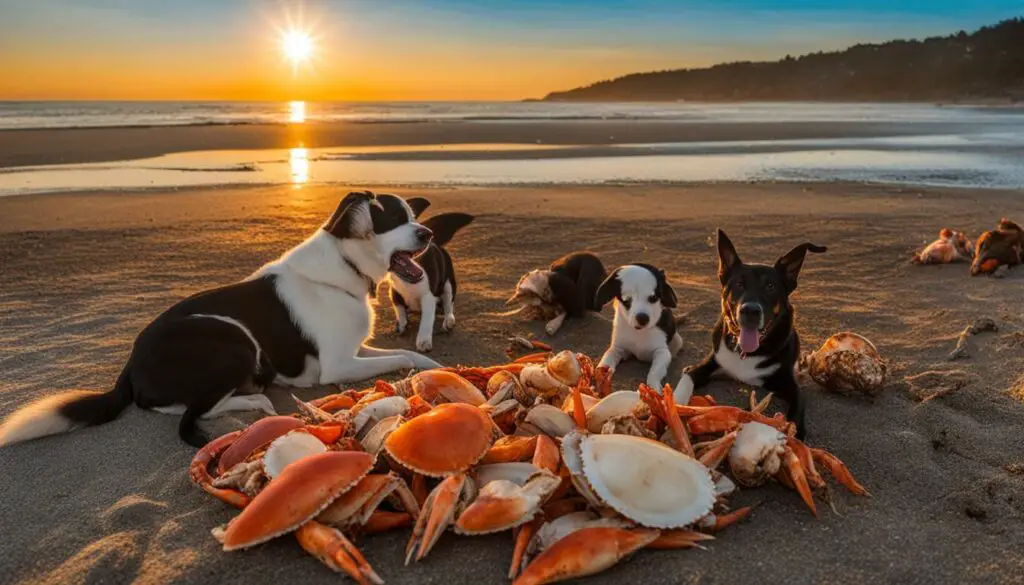
Conclusion
In conclusion, dogs can safely eat cooked crab meat as long as the shells are removed and no seasonings or additives are used. It is important to feed crab meat in moderation and be mindful of any potential allergies. By following these guidelines, owners can provide their dogs with a delicious and nutritious treat while keeping them safe from the dangers of crab shells.
My Dog Ate a Crab Shell – What Now?
If your dog has managed to eat a crab shell, it is important to take immediate action to ensure their safety and well-being. The first step is to check your dog’s throat for any signs of choking. If the shell is still lodged in their throat, it should be safely removed. However, if the shell has been swallowed, you will need to monitor your dog closely for any potential complications.
Dogs are at risk of experiencing various issues when they consume crab shells. These can include cuts and bruises in the mouth, throat, stomach, and intestines. In some cases, the sharp edges of the shell fragments can lead to digestive problems such as vomiting, diarrhea, abdominal pain, bloating, lethargy, and loss of appetite.
If you notice any concerning symptoms such as difficulty breathing, excessive drooling, severe abdominal pain, or blood in your dog’s vomit or stool, it is crucial to seek veterinary care immediately. Your veterinarian will be able to assess the situation and provide the necessary treatment to ensure your dog’s health and well-being.
| Symptoms of Complications from Crab Shell Ingestion | Immediate Actions to Take |
|---|---|
| Difficulty breathing | Seek veterinary care immediately |
| Excessive drooling | Monitor closely for any changes |
| Severe abdominal pain | Contact your veterinarian for guidance |
| Blood in vomit or stool | Seek immediate veterinary attention |
Remember, prevention is always better than cure. To avoid future incidents, it is essential to keep crab shells out of your dog’s reach. Additionally, consider feeding your dog cooked crab meat without the shells, as it can provide nutritional benefits in moderation. By prioritizing your dog’s safety and well-being, you can help ensure a happy and healthy life for your furry friend.
Potential Health Effects of Crab Shells
When dogs consume crab shells, it can have various health effects that pet owners should be aware of. The sharp edges of the shells can cause cuts and bruises in the mouth, throat, stomach, and intestines, leading to discomfort and potential bleeding. Ingesting shell fragments can also result in digestive issues such as vomiting, diarrhea, abdominal pain, bloating, lethargy, and loss of appetite.
It is crucial to monitor dogs closely if they have ingested crab shells and seek immediate veterinary attention if any concerning symptoms arise. Prompt medical care increases the chances of a successful recovery and minimizes any potential complications.

Quote: “The sharp edges of broken shells can cause choking, puncture or tear the dog’s digestive tract, and potentially lead to intestinal obstruction.”
The Importance of Prevention
Prevention is key to avoiding the potential harm that can come from crab shell consumption in dogs. Pet owners should be vigilant in keeping crab shells out of their dog’s reach, whether it be during beach trips or other outdoor activities. Properly disposing of crab shells and ensuring they are not accessible to the dog is essential to their safety.
Another crucial aspect of prevention is focusing on feeding dogs cooked crab meat instead of the shells. While crab meat can provide important nutrients, such as lean protein, vitamins, minerals, and omega-3 fatty acids, it is important to remove the shells and avoid seasoning the crab meat when offering it to dogs.
| Health Effects of Crab Shells in Dogs | Prevention Measures |
|---|---|
| Injuries in the mouth, throat, stomach, and intestines | Keep crab shells out of the dog’s reach |
| Digestive issues – vomiting, diarrhea, abdominal pain, bloating | Focus on feeding dogs cooked crab meat |
| Lethargy and loss of appetite | Properly dispose of crab shells |
By prioritizing the well-being of dogs and following these prevention measures, pet owners can help ensure their furry friends stay safe and healthy.
The Importance of Prevention
When it comes to the health and well-being of our dogs, prevention is key. This is especially true when it comes to dog-friendly crab shell consumption. While crab shells may seem harmless, they can pose serious risks to our furry friends. By taking proactive measures, we can ensure that our dogs stay safe and healthy.
Understanding the Risks
Crab shell consumption in dogs can lead to various health issues, including cuts and bruises in the mouth, throat, stomach, and intestines. The sharp edges of broken shells can cause injuries and internal damage, which may require immediate veterinary attention. Additionally, the shell fragments can also lead to digestive issues such as vomiting, diarrhea, abdominal pain, bloating, lethargy, and loss of appetite.
“It is crucial for dog owners to be aware of these risks and take necessary precautions to prevent any harm to their pets,” says Dr. Samantha Williams, a veterinarian with over 10 years of experience.
Prevention Tips
To prevent your dog from consuming crab shells, follow these important tips:
- Keep crab shells out of your dog’s reach: When enjoying a beach trip or outdoor activities where crab shells may be present, ensure that your dog is not able to access them.
- Proper disposal: Dispose of crab shells in a secure trash bin, away from your dog’s reach.
- Offer cooked crab meat instead: If you want to include crab in your dog’s diet, make sure to remove the shells and cook the meat thoroughly. Avoid seasoning the crab meat, as some seasonings can be harmful to dogs.
By being vigilant and proactive, we can prevent potential harm to our dogs and ensure their well-being. Remember, it’s always better to be safe than sorry!
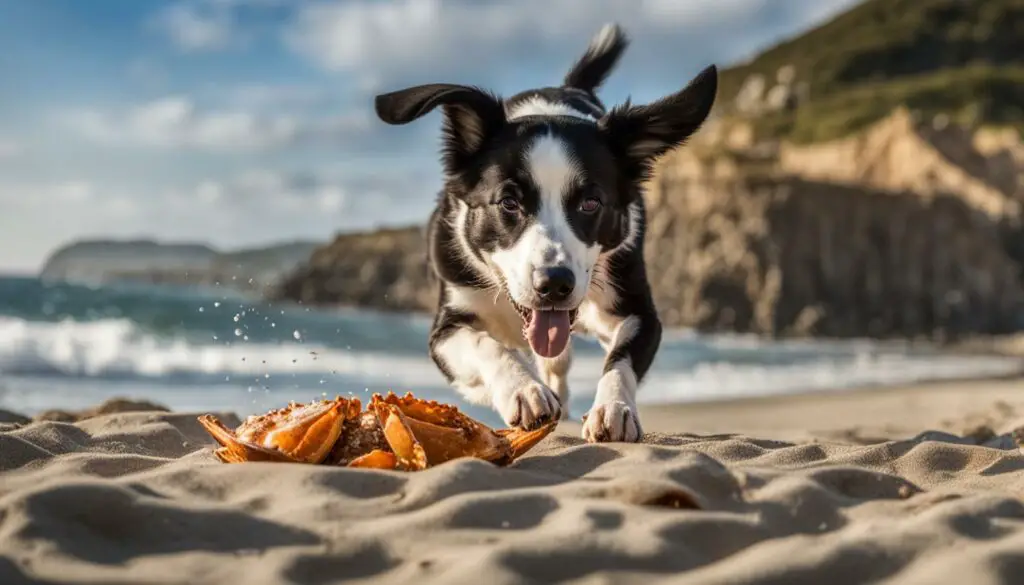
Benefits and Risks of Feeding Dogs Crab
Feeding dogs cooked crab meat can provide various benefits to their diet. Crab meat is a good source of lean protein, which is essential for muscle development and repair. It also contains important vitamins and minerals, such as vitamin B12, selenium, and zinc, which contribute to overall canine health.
Additionally, crab meat contains omega-3 fatty acids, which are beneficial for dogs’ heart health, coat condition, and joint function. These fatty acids have anti-inflammatory properties and can help reduce the risk of certain chronic diseases in dogs.
However, it is important for dog owners to be aware of the risks associated with feeding dogs crab. If not properly prepared, crab meat can contain harmful bacteria and parasites that can cause digestive upset and other health issues in dogs. It is crucial to remove the shells completely, as they can be a choking hazard and cause internal injuries if ingested.
Potential Benefits of Feeding Dogs Crab:
- Good source of lean protein
- Provides essential vitamins and minerals
- Contains omega-3 fatty acids for heart health and joint function
Potential Risks of Feeding Dogs Crab:
- Risk of bacterial and parasitic contamination
- Choking hazard from crab shells
- Possible internal injuries if shells are ingested
In conclusion, while cooked crab meat can offer nutritional benefits to dogs, it is important to prioritize their safety by properly preparing the crab and avoiding the shells. Consultation with a veterinarian is recommended to ensure that feeding dogs crab is appropriate for their specific needs and to address any concerns or questions regarding their diet.
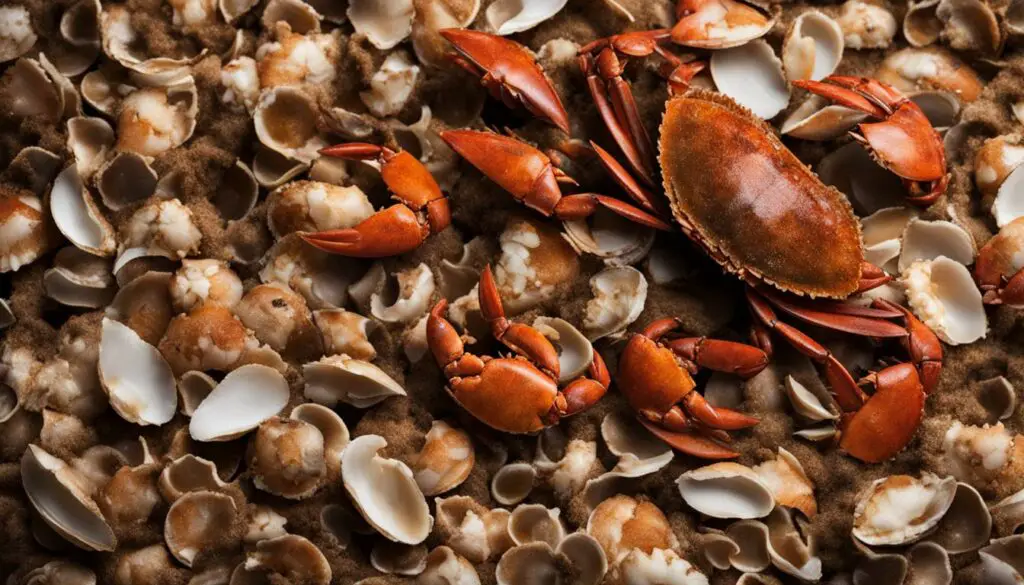
Understanding Proper Preparation of Crab for Dogs
When it comes to feeding dogs crab, proper preparation is crucial to ensure their safety and well-being. Dog owners should follow these guidelines to make sure that the crab is suitable for their pet’s diet:
- Remove the shells: Before serving crab to your dog, it is essential to remove the shells completely. The sharp edges of the shells can pose a choking hazard and cause internal injuries if ingested.
- Cook the meat: Make sure to cook the crab meat thoroughly before feeding it to your dog. This will help eliminate any potential bacteria or parasites that could be harmful to your pet.
- Avoid seasonings: Dogs should only consume plain, unseasoned crab meat. Seasonings such as salt, garlic, and onion can be toxic to dogs and should be avoided.
By following these preparation steps, dog owners can ensure that their pets can safely enjoy the nutritional benefits of cooked crab meat without the risks associated with consuming crab shells. It is always recommended to consult with a veterinarian before introducing any new food into your dog’s diet.
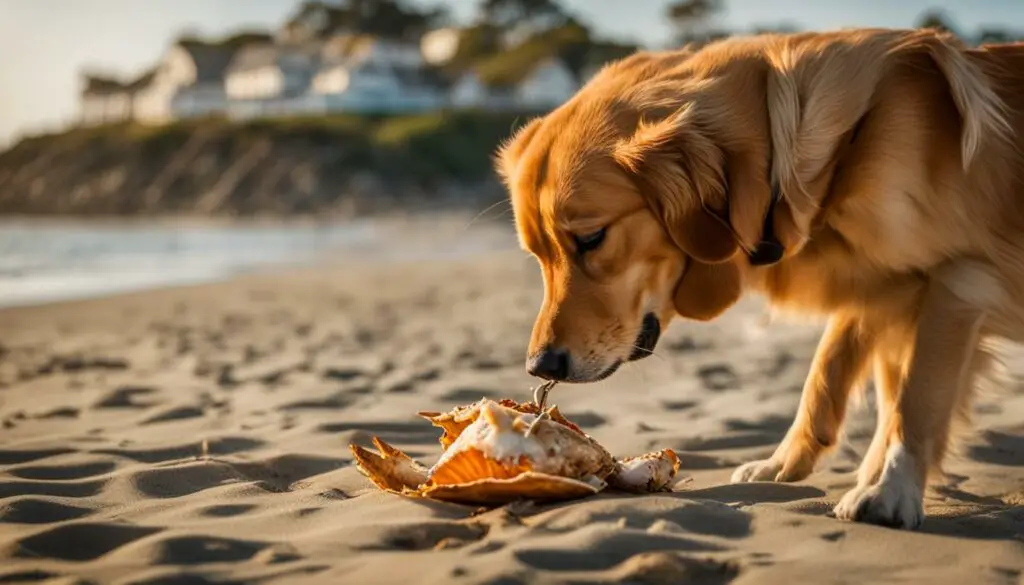
Comparing the Nutritional Value of Cooked Crab Meat for Dogs
When it comes to the nutritional value of cooked crab meat for dogs, it is important to compare it to other food options. Here is a table that showcases the nutritional content of cooked crab meat compared to some common dog-friendly ingredients:
| Ingredient | Protein | Fat | Carbohydrates | Vitamins | Minerals |
|---|---|---|---|---|---|
| Cooked Crab Meat (100g) | 18g | 1g | 0g | Vitamin B12, Zinc | Copper, Selenium |
| Chicken Breast (100g) | 31g | 3g | 0g | Vitamin B6, Niacin | Iron, Phosphorus |
| Sweet Potato (100g) | 2g | 0g | 20g | Vitamin A, Vitamin C | Potassium, Manganese |
While cooked crab meat provides protein and essential vitamins and minerals, it is important to remember that a balanced diet for dogs should include a variety of ingredients. It is recommended to consult with a veterinarian to ensure that your dog’s nutritional needs are being met.
By understanding the proper preparation of crab for dogs and comparing its nutritional value to other ingredients, pet owners can make informed decisions about incorporating cooked crab meat into their dog’s diet. Remember, moderation is key, and any dietary changes should be made under the guidance of a veterinary professional.
Moderation and Allergies
When it comes to feeding dogs crab, moderation is key to ensure their safety and well-being. While cooked crab meat can be a healthy addition to their diet, it should be given in small amounts to prevent potential health issues associated with excessive consumption. Dogs have different dietary requirements than humans, and their systems may not be able to handle large quantities of crab meat.
Additionally, it is important for dog owners to be aware of potential allergies and allergic reactions that their pets may have to crab. Just like humans, dogs can develop allergies to certain foods, including crab. If you’re introducing crab to your dog’s diet for the first time, it is recommended to start with a small portion and closely monitor for any adverse reactions. Signs of an allergic reaction may include itching, rashes, swelling, difficulty breathing, or gastrointestinal distress.
It is always best to consult with a veterinarian before introducing any new food to your dog’s diet, especially if they have a history of allergies or digestive issues. Your vet can provide guidance on appropriate portion sizes and help determine if crab is suitable for your dog based on their specific health needs.
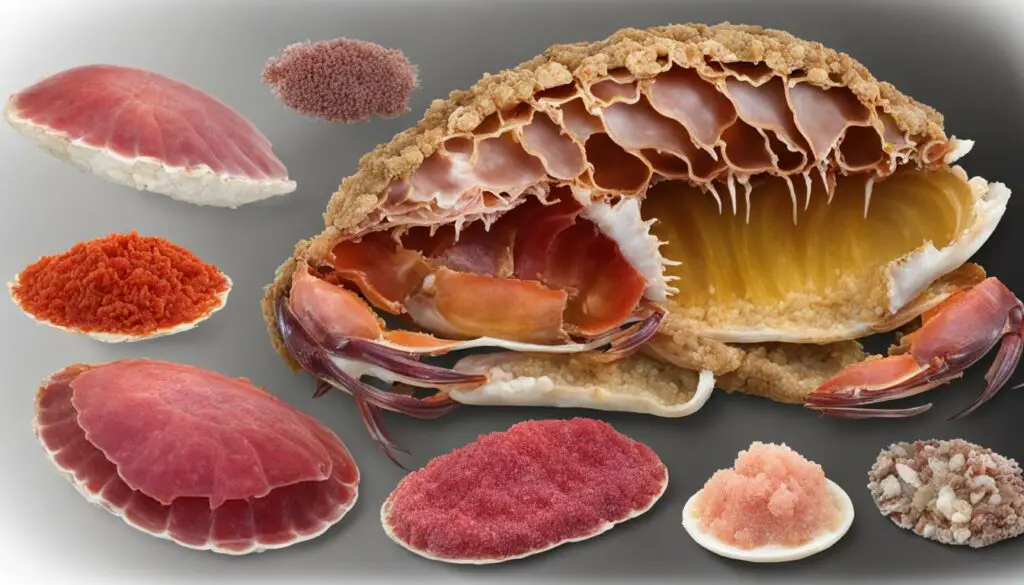
In conclusion, while dogs cannot safely eat crab shells, cooked crab meat can be a healthy addition to their diet when given in moderation. However, it is important to be aware of potential allergies and monitor your dog for any adverse reactions. Consult with a veterinarian to ensure that crab is suitable for your dog and to receive guidance on proper portion sizes. By practicing moderation and staying vigilant, you can keep your furry friend safe.
Other Safe Foods for Dogs
While it’s important to understand the potential risks of feeding dogs crab shells, there are plenty of other safe and nutritious foods that can be incorporated into their diet. By offering a balanced and varied selection of dog-friendly foods, pet owners can ensure the overall health and well-being of their furry companions.
The Benefits of Seafood
Seafood, when properly prepared, can be a healthy addition to a dog’s diet. It is a rich source of lean protein, essential vitamins, minerals, and omega-3 fatty acids, which support heart health, joint function, and a shiny coat. However, it’s crucial to remove any bones and shells before serving seafood to dogs. Additionally, some types of seafood, such as salmon, can contain parasites, so it’s important to cook it thoroughly to eliminate any potential health risks.
Nutritious Fruits and Vegetables
Select fruits and vegetables can also provide valuable nutrients to dogs. Apples, carrots, and blueberries are excellent options that are packed with vitamins, fiber, and antioxidants. These colorful foods can support the immune system, improve digestion, and promote overall well-being. However, it’s important to avoid feeding dogs grapes, raisins, onions, and garlic, as these can be toxic to them.
Plant-Based Protein Sources
In addition to animal-based proteins, dogs can also benefit from incorporating plant-based protein sources into their diet. Foods like beans and lentils are high in protein, fiber, and essential minerals. They can help support muscle development, provide energy, and contribute to a healthy digestive system. However, it’s crucial to properly cook these legumes and avoid adding any seasonings that may be harmful to dogs.
By offering a variety of safe and nutritious foods, pet owners can ensure that their dogs receive a well-rounded and balanced diet. It’s important to consult with a veterinarian to understand specific dietary needs and to monitor for any potential allergies or adverse reactions. Remember, moderation is key, and a varied diet will help keep our furry friends happy and healthy!
| Foods | Benefits |
|---|---|
| Seafood | Rich in lean protein, vitamins, minerals, and omega-3 fatty acids |
| Fruits and Vegetables | Packed with vitamins, fiber, and antioxidants to support overall well-being |
| Plant-Based Protein Sources | Beans and lentils provide protein, fiber, and essential minerals |
Conclusion
After careful consideration, it is clear that dogs should not consume crab shells. The potential health effects and risks associated with their ingestion can be harmful to our beloved pets. However, cooked crab meat can be a healthy addition to a dog’s diet when prepared properly and served in moderation.
It is important for dog owners to prioritize their pet’s safety and well-being by understanding the dangers associated with crab shell consumption. The sharp edges of broken shells can cause choking, internal injuries, and intestinal blockage. Seeking immediate veterinary care is crucial if a dog has ingested crab shells and exhibits concerning symptoms.
By practicing prevention and removing access to crab shells, pet owners can minimize the risks associated with their consumption. Additionally, exploring other safe food options such as properly prepared seafood, select fruits and vegetables, beans, and nuts can provide nutritional benefits to dogs.
In conclusion, while dogs cannot safely eat crab shells, cooked crab meat can be enjoyed by our furry friends in moderation. As responsible dog owners, it is our duty to be aware of the potential health effects and take proactive measures to keep our pets safe and healthy.
FAQ
Can dogs safely eat crab shells?
No, dogs should not consume crab shells as they can pose potential dangers. The sharp edges of broken shells can cause choking, puncture or tear the dog’s digestive tract, and potentially lead to intestinal obstruction.
What should I do if my dog ingests crab shells?
If your dog has consumed crab shells, it is important to contact a veterinarian or Pet Poison Helpline immediately. They will provide guidance on the best course of action.
What are the symptoms of crab shell ingestion in dogs?
Symptoms of crab shell ingestion in dogs may include diarrhea, vomiting, constipation, abdominal pain and swelling, weakness, loss of appetite, and lethargy. These symptoms indicate a potential emergency, and veterinary attention should be sought immediately.
How can I prevent my dog from eating crab shells?
To prevent your dog from eating crab shells, it is essential to keep them out of your dog’s reach. Be vigilant during beach trips or other outdoor activities and make sure to properly dispose of crab shells.
Can dogs eat cooked crab meat?
Yes, cooked crab meat can be a healthy addition to a dog’s diet in moderation. It provides important nutrients such as lean protein, vitamins, minerals, and omega-3 fatty acids. However, the shells should be removed, and the crab meat should be served plain, without any seasonings.
What should I do if my dog has eaten a crab shell?
If your dog has eaten a crab shell, check their throat for signs of choking. If the shell is still lodged, it should be safely removed. However, if the shell has been ingested, monitor your dog for signs of blockage or internal bleeding and seek veterinary care if any concerning symptoms arise.
What are the potential health effects of consuming crab shells?
Ingesting crab shells can cause cuts and bruises in the mouth, throat, stomach, and intestines of dogs. It may also lead to digestive issues such as vomiting, diarrhea, abdominal pain, bloating, lethargy, and loss of appetite. Immediate veterinary attention is necessary for the best chance of recovery.
How can I prevent my dog from consuming crab shells?
To prevent your dog from consuming crab shells, ensure they cannot access them. Keep crab shells out of their reach during beach trips or other outdoor activities. Focusing on feeding dogs cooked crab meat instead can help ensure their safety.
Are there any other safe foods for dogs?
Yes, there are other safe food options for dogs. Seafood (properly prepared), select fruits and vegetables, beans, and nuts can be safely incorporated into a dog’s diet. It is important to offer a balanced and varied diet to prioritize their overall health and well-being.

